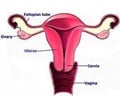The incidence of uterine papillary serous carcinoma (UPSC) has increased since it was first identified in 1981.
The incidence of uterine papillary serous carcinoma (UPSC) has increased since it was first identified in 1981. The condition was initially regarded as easy to treat until about 1990 when a number of persons were diagnosed with the aggressive cancer. It has remained a significant problem since then.
UPSC is found in higher rates in African American women than in white women. The disease looks like ovarian cancer and spreads just as rapidly, restricting the choice of treatment to only chemotherapy.A state-of-the-art treatment program now developed at Yale School of Medicine has been found to increase survival from the aggressive uterine papillary serous carcinoma (UPSC) sparing the need for additional therapy in some patients.
According to the study, it has been that a combination of platinum-based chemotherapy and vaginal radiation to be the most effective treatment for the disease. This has infact led to the establishment of a standard of care being established for this type of uterine cancer.
Moreover, it can also be used to evaluate the need for additional treatment following surgery and hence determine the prognosis. The survival rates of women have considerably increased with reduction in the recurrence rates.
The study was conducted on a group of 74 patients with UPSC who underwent complete surgical staging, or hysterectomy with removal of lymph nodes and fat pads. Cancer recurred in 43 percent of early stage patients who did not receive chemotherapy, while in the 20 percent of patients who received platinum-based chemotherapy there were no recurrences. About 14 patients were spared additional radiation treatment.











